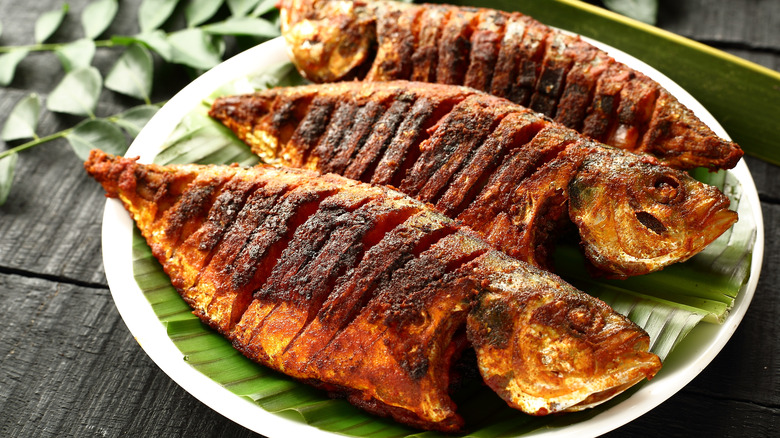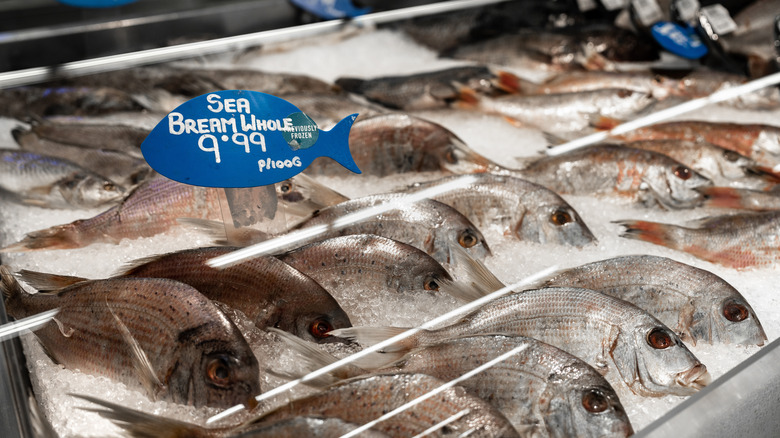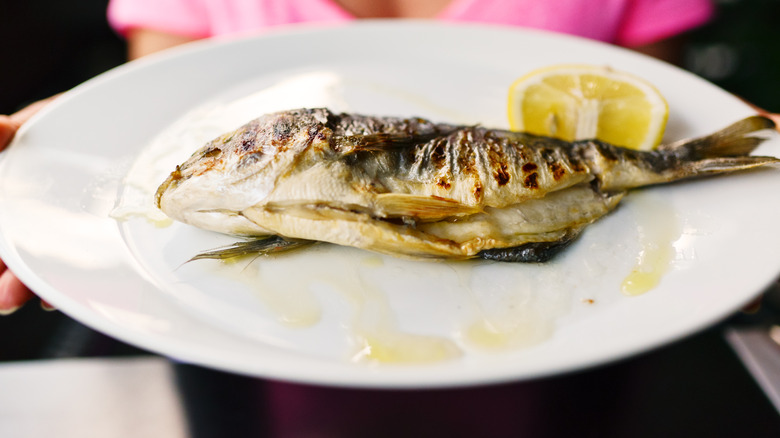You Should Be Grilling More Fish Whole, Your Wallet Will Thank You
If you follow food trends you might have heard that whole fish is having a moment. For decades many Americans were squeamish about seeing fish heads in general, especially served on a plate, preferring tidy fillets and steaks. The tides are turning, however, and more chefs and diners are embracing nose-to-tail cooking, which uses every part of an animal. Feast Magazine flagged the rise of whole fish back in 2016 after noticing them pop up on several restaurant menus, and the movement has only gathered momentum. These days nearly every trendy seafood-focused restaurant has a whole fish or two on offer.
Cooking and serving a whole fish is the sort of thrifty and sustainable culinary trick that chefs love because the presentation is on trend, there's no waste, the food cost is low, and there isn't a lot of complicated cutting to do. These are all great reasons to try cooking whole fish at home. Plus, it's really easy to do, especially if you like to cook on the grill. As a bonus, shopping for whole fish will guarantee that you'll always get the best seafood because there are more places to inspect the animal for signs of freshness. Your local fishmonger may even give you a little extra street cred for going whole.
Select the fish, save some money
Before you fire up the grill, the first step when making a whole grilled fish is to select the best specimen. British chef Rick Stein recommends giving the whole fish a once-over to check the gills, skin, eyes, and fins, which you don't get to see when you buy fish as fillets. The gills should also be shiny; steer clear of any gills that are looking brown. The skin should be shiny and still have a slick, natural surface, and the fins should look intact and healthy (not ripped or broken). Finally, the eyes should be clear and bright. If you can't get up close to inspect the gills, you can at least see the eyes, and avoid any fish with eyes that are cloudy and sunken. If you're shopping at a place where you can talk to the fishmonger and get close enough to smell the fish before you buy it, look for fish that doesn't smell; a fishy odor means the fish isn't fresh.
Seafood is expensive, so you might be surprised to find that buying whole fish is cheaper than individual cuts. This is because buying a whole fish is like buying anything in bulk — the less it's processed, the better price you'll get per pound, according to Pure Food Fish Market in Seattle. Buying a whole fish also cuts way down on seafood mislabeling and fraud.
Prep the fish and grill
Before you leave the market with your bounty, ask the fishmonger to clean and scale the fish. Any reputable fish counter should do this for free.
Grilling fish is almost as easy as grilling steak, you just need to make sure it doesn't stick to the grate, which will tear the skin and ruin the presentation. You also need to watch the heat so that you don't burn the outside without cooking the inside.
When you're ready to start cooking, Martha Stewart suggests preheating your grill with two heat zones. One side should be nice and hot for searing (around 500 degrees Fahrenheit), while the cooler area (around 225 to 375 degrees Fahrenheit) is for making sure the meat is cooked through without burning. Start your whole fish out in the hot zone to sear the skin, then move it to the cooler zone to cook to a USDA-approved internal temperature of 145 degrees Fahrenheit.
Fish skin is more delicate than the surface of, say, a T-bone steak, so before you start cooking, make sure that the grill surface is clean and well-oiled to prevent sticking. Be restrained when coating the outside of your fish with oil to avoid stoking the flames. For a little extra help, you can invest in a fish grilling basket — just oil it first. If you've prepped your fish and grill properly, however, and watch your temperatures, you should have no problems cooking your whole fish to perfection.


